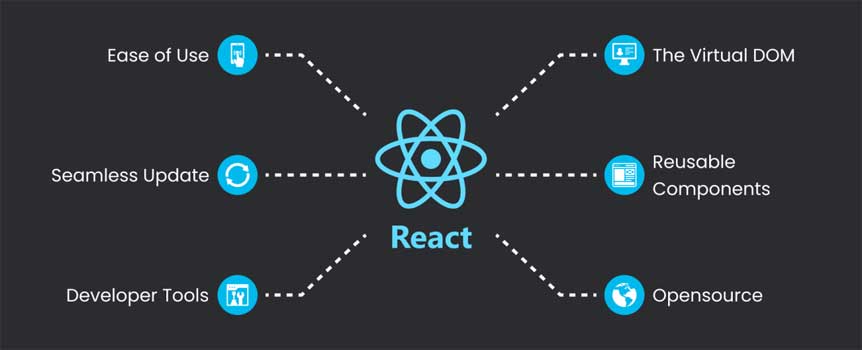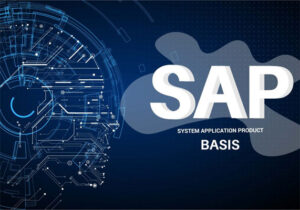
by Sanjoy Dutta | Jan 20, 2024 | SoftSkill Training, Software training
React was designed to create sophisticated user interfaces using a very simple and clear syntax. It allows developers to build reusable components, write less code for UI implementation, and achieve better performance and stability. It’s also highly scalable, allowing engineers to build web applications of any size. Additionally, React is extremely SEO friendly and is ideal for websites requiring lightning-fast loading, such as eCommerce sites with thousands of products or real estate portals with interactive maps, filters, and dynamic content.
The most popular use case for React is developing applications with a large amount of data and changing it often. To keep the application fast, React uses a virtual DOM (Document Object Model). The virtual DOM is a copy of the actual DOM, and every time there is a change in the data state, React will update the virtual DOM first. It then compares the virtual DOM to the actual DOM and figures out which parts of the page have changed. Then, React will figure out the least expensive way to patch the changes in the real DOM without rendering it again. This approach avoids layout trashing and significantly improves performance.
React is also a great tool for creating complex user interfaces with many components, as it makes it easy to manage changes and the relationship between data and what appears on the screen. In comparison, jQuery can be challenging for such tasks due to its heavy and slow memory footprint.

One of the main reasons React is so popular is its ability to debug quickly and efficiently. The React framework uses unidirectional data flow, making it easier to track and debug errors. Additionally, React JS uses a virtual DOM, which is a lightweight copy of the real DOM, and this enables faster rendering and loading of web pages.
React also enables developers to create more structured and organized codebases. This is particularly beneficial for teams that have to deal with large-scale projects and numerous components, states, and data flows. It’s no surprise that React is a great choice for forums, job boards, e-learning sites, and any other platform that
requires high levels of interaction between users.
React has become an indispensable tool for thousands of companies, including some Fortune 500 brands, like PayPal, Netflix, Tencent QQ, and Airbnb. In addition to providing a rich library of ready-made UI components, React has helped them achieve lightning-fast load times and better search engine optimization. As a result, they have seen an increase in traffic and sales. Moreover, React can be used to develop both web and mobile apps.

by Sanjoy Dutta | Jan 13, 2024 | Software training
Mainframe computers, referred to as big iron in some circles, are used in areas that cannot be handled by a mini-computer. The mainframe’s architecture allows for high volumes of users and transactions. It has a large memory capacity and can process a high volume of data at a very rapid rate. This makes it ideal for processing large amounts of information and storing massive databases.
It is also capable of running multiple operating systems simultaneously on a single machine. Typical combinations include z/OS, z/VSE, Linux for System z, and z/TPF. These systems are highly stable and reliable, with mean time between failure measured in decades. The scalability of mainframes means that businesses can add or remove capacity without interrupting operations.
Mainframes were once found in almost every business, but today they are used primarily by large companies for mission-critical applications. These include censuses, industry and consumer analytics, enterprise resource planning, and large transaction processing. These applications are so important to the company’s success that they must be available around the clock. Pausing them to update software could be costly for the organization, or even endanger national security in some cases.


Airlines use mainframes to keep track of flight networks and passengers, a huge task that requires the ability to handle enormous amounts of data quickly and accurately. These systems are also used by many traditional brick-and-mortar stores to manage inventory and by many online retailers as well.
Banks, both investment banks and plain-old retail banks, rely on mainframes to process the massive amount of transactions they generate. From credit card processing and ATM withdrawals to online account updates, these systems provide the reliability and scalability that commodity servers simply can’t match.
There were several mainframe competitors in the past, including Univac, Sperry, Amdahl, and GE. However, IBM now dominates the market for these computers. Until recently, mainframes were so expensive that only very large companies could afford them. However, recent advancements in cloud computing and clustering have made them more affordable for smaller businesses as well. For this reason, mainframes will continue to play an essential role in many industries for years to come.

by Sanjoy Dutta | Jan 12, 2024 | Software training
Selenium is an open-source tool that is widely known for its ability to help testing teams develop test scripts in a variety of programming languages. This helps in automating the tests and also ensures that the test results are accurate and reliable. It is also able to generate detailed reports of each test run. These reports can be used to identify areas that need improvement and take corrective action. The user-friendly interface of Selenium makes it easy for the entire team to create and execute tests.
This software testing framework can be used to test web applications on multiple platforms and browsers. It can help in identifying bugs and issues quickly and easily. Moreover, it can help in the development of automated tests to reduce the time spent on manual testing. This will allow the testers to focus more on improving the application and also get the highest ROI.
Besides, the Selenium tool is capable of running multiple tests in parallel, which will speed up the overall test process. This feature is particularly helpful in testing large web applications that have a huge number of pages and functions. It can also be used to perform end-to-end testing, which is not possible with other software testing tools such as QTP, UFT, and SilkTest.

The Selenium automation testing tool consists of several components, such as Selenium IDE, Selenium WebDriver, and Selenium Grid. Each component is designed to serve a particular purpose. For instance, the WebDriver is designed to communicate with a browser through different drivers. It takes a series of commands and sends them to the browser to initiate responses. The grid is another tool that can be used to test the web application in a variety of operating systems and browsers.
Selenium enables you to use a number of programming languages to write your automation test scripts, such as Java, Python, Perl, and Ruby. This is why it is considered one of the most versatile test automation tools in the market. Additionally, it supports various browsers such as Chrome, Firefox, Safari, Internet Explorer, and Opera. This means that you can run your tests against these popular web browsers without having to rewrite the script.
However, despite its many benefits, there are a few drawbacks to using Selenium for automation testing. It is important to note that this tool only works on web applications and does not support mobile or desktop applications. It is also not an all-in-one automation testing solution and requires third-party tools for additional functionality, such as image recognition. The most common tool for this purpose is Sikuli, which can be integrated with the Selenium framework to improve its functionality.
Another drawback of using Selenium is that it can be difficult to troubleshoot problems. Unlike licensed software, which comes with an in-house support team, you must rely on online community groups and chat rooms to address any issues you encounter while setting up the tool. This can be a challenge for larger enterprise projects, especially when you need to resolve the issue as soon as possible.

by Sanjoy Dutta | Jan 6, 2024 | Software training
SAP Basis is the software that manages and runs your SAP landscape. It is an essential tool for organizations to ensure that their SAP systems are running smoothly and efficiently. Without a strong, well-managed SAP Basis team, your organization could face costly outages and other issues that can impact business operations.
In our latest Q&A series, we spoke with experts Deb Donohoe and Christian Baessler from Syskoplan Reply (formerly Enowa) to learn more about the importance of SAP Basis administration. They also discussed how SAP HANA has changed the role of the Basis administrator and provided some tips on how to successfully manage your SAP environment.
SAP Basis, more commonly known as NetWeaver, is the underlying layer of an SAP system. It provides the functionality needed to connect all of your applications, systems, and databases. It enables businesses to integrate business processes across all applications and departments, increasing efficiency and productivity.
 It allows users to create custom applications and web pages using ABAP (Advanced Business Application Programming) or Java stacks. The software can be used for both on-premise and cloud computing environments, making it flexible and accessible to companies of all sizes. In addition to connecting your SAP applications, NetWeaver also helps you integrate your IT infrastructure and data with third-party tools such as BI Portal, PI, and SRM.
It allows users to create custom applications and web pages using ABAP (Advanced Business Application Programming) or Java stacks. The software can be used for both on-premise and cloud computing environments, making it flexible and accessible to companies of all sizes. In addition to connecting your SAP applications, NetWeaver also helps you integrate your IT infrastructure and data with third-party tools such as BI Portal, PI, and SRM.
With a robust architecture, SAP Basis also supports enterprise-level integrations and offers built-in security features that make it more secure than other database platforms. The ability to replicate data enables administrators to set up and test new database upgrades without affecting production systems.
The software consists of multiple components, including the SAP NetWeaver Application Server (ABAP), and SAP Solution Manager. ABAP and SAP Solution Managers are the main tools that help you monitor your SAP system, transfer changes from development to a production environment, analyze logs, create reports, and perform other tasks.

Many people think that SAP HANA has made the job of SAP Basis admins easier. However, this is not entirely true. While HANA has automated many monitoring tasks, it has not eliminated the need for a strong and skilled Basis administrator team. This is particularly true for businesses with large and complex SAP landscapes, where a single issue can cause severe financial losses.
While building an in-house SAP Basis administration team is a viable option, it can be costlier than outsourcing the work to a third-party company that can provide 24/7 support. When choosing a provider, look for one that has extensive experience managing complex SAP landscapes and can offer an end-to-end support service, so that you don’t have to worry about anything other than running your business. This is especially important when you are planning for a major project like SAP migration to S/4HANA. Having a team of professionals handle your SAP Basis will save you time and money in the long run. If you’re interested in hiring a dedicated SAP Basis administration team, contact us today for more information!

by Sanjoy Dutta | Jan 6, 2024 | Software training
Microsoft’s Azure platform is an infrastructure as a service (IaaS) cloud computing system that uses large-scale virtualization in Microsoft data centers and offers over 600 different services. It is a pioneering leader in the field of IaaS and offers businesses several key benefits to help them become more competitive.
One of the unique features that Microsoft Azure provides to its customers is a set of machine learning models called Cognitive Services. These are machine-learned tools that can be run through the Azure portal by customers without the need to write code to do so. These machines learned tools can be used to solve a variety of tasks that would otherwise be difficult or impossible for noncoders to do.

Another way that businesses can leverage the unique capabilities of Azure is by using its scalable infrastructure to grow with their business needs. This allows businesses to quickly add more computing resources or storage capacity to handle additional workloads without the need for costly upgrades in their IT infrastructure.
Additionally, Azure offers a pay-as-you-go pricing model that allows businesses to scale their usage based on the amount of work they do. This helps them to avoid spending more than they need, as well as save money by only paying for what they use.
Other features that are provided by Azure to its customers include the ability to create a Content Delivery Network which can be used to cache the output of some services so that they load faster for users around the world. This service is easy to set up and configure through the Azure portal for any users with an appropriate subscription level and can be done at no extra cost.
 Finally, Azure has a wide range of security tools that are designed to protect customer information from being accessed by malicious parties. These include security policies, role-based access control, encryption, and other features that can be used to keep sensitive information safe. These are the types of features that businesses can use to be more secure, which is becoming increasingly important in an era when cybersecurity threats are on the rise.
Finally, Azure has a wide range of security tools that are designed to protect customer information from being accessed by malicious parties. These include security policies, role-based access control, encryption, and other features that can be used to keep sensitive information safe. These are the types of features that businesses can use to be more secure, which is becoming increasingly important in an era when cybersecurity threats are on the rise.
For businesses looking to take advantage of the unique features that Microsoft Azure has to offer, they can sign up for a free trial or contact one of the many authorized resellers of the system in their area. These resellers can assist with getting a business up and running with Microsoft Azure, as well as provide the necessary training and support to help them make the most of it. These resellers can also help with migrating any data that a business may need to carry over to the Azure platform. This is important for small to medium-sized businesses that don’t have the time or budget to spend on an in-house IT team. Having a partner that can help them get started with Azure and migrate any existing systems to it is a good way for these smaller companies to make the most of their resources and stay competitive in the modern marketplace.

by Sanjoy Dutta | Dec 30, 2023 | Software training
The SAP Business Application Software Integrated Solution (SAP Basis) is an essential administrative tool used to maintain and optimize SAP environments. It supports many of the features and functions required for SAP software and business systems to function effectively, including monitoring server instances, managing data storage, creating and implementing various system management tools, facilitating interfacing and integration processes between SAP and external systems, and more.
As a result, an SAP BASIS expert is responsible for a wide range of important tasks on a day-to-day basis and requires a broad set of skills, spanning both SAP-specific knowledge as well as knowledge of general IT and computer systems. For this reason, it’s important to choose a multi-skilled SAP support provider who will be able to manage the whole scope of your business’s SAP needs.
 One of the most important benefits that an SAP Basis team can provide is ensuring 24/7 support for your company’s systems, helping to avoid any potential downtime or disruption. Additionally, SAP Basis experts are often able to troubleshoot issues and resolve them quickly, thanks to their familiarity with your company’s infrastructure and the tools that it uses every day. Lastly, SAP Basis professionals also help to streamline and automate business processes, saving time and resources that can be better spent on more crucial tasks. Furthermore, they facilitate smooth system upgrades and migrations, ensuring that any changes are implemented in an efficient manner without any disruption to daily business operations.
One of the most important benefits that an SAP Basis team can provide is ensuring 24/7 support for your company’s systems, helping to avoid any potential downtime or disruption. Additionally, SAP Basis experts are often able to troubleshoot issues and resolve them quickly, thanks to their familiarity with your company’s infrastructure and the tools that it uses every day. Lastly, SAP Basis professionals also help to streamline and automate business processes, saving time and resources that can be better spent on more crucial tasks. Furthermore, they facilitate smooth system upgrades and migrations, ensuring that any changes are implemented in an efficient manner without any disruption to daily business operations.
SAP Basis professionals are also trained to provide a variety of other services and tools that can make your business more efficient, such as backups, monitoring and execution of background jobs, and more. As a result, they can improve overall system performance, which leads to greater productivity and a more streamlined workflow.
When you are looking for a SAP BASIS professional, finding the right one can feel like an overwhelming task. However, today’s talent platforms can make this process much easier, providing carefully curated catalogues of experienced professionals that are matched to projects with the best fit. In addition, the right platform can make it easy to find a professional on either a permanent or temporary basis, based on your specific needs.
At 1st SAP, we understand that each business is unique and has its own set of requirements for how its IT should work. As a leading SAP Basis support company, we are dedicated to providing the highest quality services to our clients and partners. We take the time to get to know your company and tailor our support to your requirements, so that you can rest assured knowing that your SAP environment is always running at peak performance. Contact us today to learn more about how our SAP Basis administration can benefit your organization. We look forward to working with you.









 It allows users to create custom applications and web pages using ABAP (Advanced Business Application Programming) or Java stacks. The software can be used for both on-premise and cloud computing environments, making it flexible and accessible to companies of all sizes. In addition to connecting your SAP applications, NetWeaver also helps you integrate your IT infrastructure and data with third-party tools such as BI Portal, PI, and SRM.
It allows users to create custom applications and web pages using ABAP (Advanced Business Application Programming) or Java stacks. The software can be used for both on-premise and cloud computing environments, making it flexible and accessible to companies of all sizes. In addition to connecting your SAP applications, NetWeaver also helps you integrate your IT infrastructure and data with third-party tools such as BI Portal, PI, and SRM.


 Finally, Azure has a wide range of security tools that are designed to protect customer information from being accessed by malicious parties. These include security policies, role-based access control, encryption, and other features that can be used to keep sensitive information safe. These are the types of features that businesses can use to be more secure, which is becoming increasingly important in an era when cybersecurity threats are on the rise.
Finally, Azure has a wide range of security tools that are designed to protect customer information from being accessed by malicious parties. These include security policies, role-based access control, encryption, and other features that can be used to keep sensitive information safe. These are the types of features that businesses can use to be more secure, which is becoming increasingly important in an era when cybersecurity threats are on the rise.
 One of the most important benefits that an SAP Basis team can provide is ensuring 24/7 support for your company’s systems, helping to avoid any potential downtime or disruption. Additionally, SAP Basis experts are often able to troubleshoot issues and resolve them quickly, thanks to their familiarity with your company’s infrastructure and the tools that it uses every day. Lastly, SAP Basis professionals also help to streamline and automate business processes, saving time and resources that can be better spent on more crucial tasks. Furthermore, they facilitate smooth system upgrades and migrations, ensuring that any changes are implemented in an efficient manner without any disruption to daily business operations.
One of the most important benefits that an SAP Basis team can provide is ensuring 24/7 support for your company’s systems, helping to avoid any potential downtime or disruption. Additionally, SAP Basis experts are often able to troubleshoot issues and resolve them quickly, thanks to their familiarity with your company’s infrastructure and the tools that it uses every day. Lastly, SAP Basis professionals also help to streamline and automate business processes, saving time and resources that can be better spent on more crucial tasks. Furthermore, they facilitate smooth system upgrades and migrations, ensuring that any changes are implemented in an efficient manner without any disruption to daily business operations.